XXIV
 The poor at enclosing do grudge,
The poor at enclosing do grudge,
because of abuses that fall,
Lest some men should have but too much,
and some again nothing at all.
In the spring and summer of 1549 the commons of England rose in massive protest against the government. There was violence in Hertfordshire, Essex, Norfolk, Gloucestershire and a half dozen other places; in Oxfordshire an incipient revolt broke out. In Cornwall pent-up grievances exploded early in June when by government order the new English communion service was read on Whitsunday in place of the Latin mass. The following day the parishioners of one Cornish village forced their priest to promise to bring back the mass, and before long the new service was thrown out in many Cornish towns and the mass restored. Meanwhile parts of Devon had risen and a large crowd was massing for an assault on Exeter, the largest town in the West Country.
The rebels besieged the town while the force sent by the Council to subdue them stood by and did nothing. The commander Lord Russell, a seasoned veteran of Henry’s campaigns, saw that his fighting men were too few, and waited for reinforcements. As he waited the rebel army grew stronger, and the siege of Exeter gave added urgency to the insurgents’ demands. They complained of food shortages and high prices, but their principal demands concerned the religious changes. They wanted to keep the mass and to have the old statues and pictures of Jesus, the virgin Mary and the saints restored. The litanies, offices and familiar sacraments should be brought back, they insisted, along with the blessed bread and holy water, and at Eastertime, the palms and ashes. Two of their demands show how eager they were to return to the days before reform doctrines had been mooted in England: they wanted two abbeys rebuilt in every country, and they wanted Cardinal Pole to be brought back from his exile and placed in King Edward’s Council.
In August the West Country rebels were finally defeated, but not before the commons of Norfolk had risen in a widespread and potentially dangerous protest that had something of the millennial character of medieval popular revolts. Led by the wealthy tanner Robert Ket, the Norfolk rebels tore through the grazing lands around Norwich, pulling up fences, breaking hedges and obliterating every boundary marker that symbolized the private seizure of what had been common land. After a time they gathered in a huge camp at Mousehold Heath, two miles from Norwich, and as their numbers grew they set up a loosely organized community whose leaders called themselves “commissioners” of the “King’s Great Camp at Mousehold.” There were at least ten thousand of them—some said nearer twenty—and it took an alarmingly large royal force to subdue them. Dudley was at the head of that force. He took Norwich on August 24, and three days later faced Ket and his men at Dussindale. Leaving much of the fighting to his German mercenaries, Dudley’s men carried out a merciless slaughter. When the battle ended, more than three thousand rebels lay dead on the field. The survivors straggled home, their leaders seized as prisoners and executed. Ket was hanged on Norwich Castle, and nine others on the “Oak of Reformation” on Mousehold Heath.
The revolts of 1549 seemed to confirm the worst fears of the Council—that beneath the uneasy acquiescence of the people lay deep dissatisfactions with religion and government which an inflammatory incident or a popular leader could trigger into violence. In mid-July, when the revolts in the west and north were in full cry, spontaneous uprisings in the counties around London made Council members frightened for their own safety. Mobs of angry tenants moved in disorderly fashion toward the capital, coming so dangerously close that at one point they broke the fences of one of the king’s parks at Elton near Greenwich. It was said they planned to besiege London until all rebel prisoners were returned to them alive, and rumors of every sort—including revived fears of reprisals against foreigners—spread throughout southern England in the anxious weeks before the rebellions ended.1
Behind the rebels’ immediate grievances lay the pent-up frustrations of decades of severe hard times in the countryside. The process known as enclosure, in which large areas of farmland and the meadows and pastures that for centuries had been held in common were fenced in by landlords to make grazing land for sheep, swept away many small farms and caused entire villages to shrink or to disappear altogether. Social critics of the time bemoaned the hundreds of deserted villages to be found throughoutEngland, their ruined churches and houses a poignant witness to the once flourishing rural life that had gone forever. Sometimes the very ruins themselves were obliterated. “I know towns,” wrote one observer, “so wholly decayed, that there is neither stick nor stone standing.”
The displaced farmers wandered the roads searching for another few acres to make a fresh start. Some made it to the capital, and survived there; many did not, and became a marginal vagabond population, distrusted by all who saw them and treated with brutality or indifference by the government that feared them. Those who hung on to their farms amid the upheaval in rural life found themselves faced with enormous increases in rents and other fees; landlords were accused of inhuman exploitation and every sort of rapacity. Edward VI’s Primer contained a “Prayer for Landlords” asking God that “they, remembering themselves to be thy tenants, may not rack, and stretch out the rents of their houses and lands.” Between the enclosing of the fields and the raising of rents fewer acres were being farmed, so that as the numbers of the landless and the unemployed grew, there was less and less food to go around. A contemporary believed that for every plow idled six men lost their livings, and seven more their sustenance. And this at a time when the population as a whole was increasing faster than at any time in the last two hundred years.
In the face of this turmoil the frightened members of the ruling Council took refuge in shrill reiterations of the importance of obedience and maintenance of the social order. To be discontented with one’s lot was a sin against the divine order, they insisted. For God has ordained that “some are in high degree, some in low, some kings and princes, some inferiors and subjects, some rich and some poor,” and to chafe against these preordained categories was to loose the evils of “abuse, carnal liberty, enormity, sin and babylonical confusion.”2 Take away the agents of the divinely appointed social hierarchy—rulers, magistrates, judges and the natural leaders, the aristocracy—and the result would be that “no man shall ride or go by the highway unrobbed, no man shall sleep in his own house or bed unkilled, no man shall keep his wife, children and possessions in quietness.”
Beyond making pronouncements such as these the government did little to alleviate the crisis. The one positive policy was the ill-advised expedient of debasing the coinage. Henry VIII had periodically ordered more base metal mixed with the gold and silver of his coins, and in other ways manipulated the currency for profit. He made perhaps half a million pounds in this way to add to his treasury, but by the 1540s his debts were so huge that the profit from the mint could not begin to cancel them. The 1544 campaign in France and the border warfare with the Scots in the final years of his reign cost him more than two millionpounds, and he had to borrow heavily from the merchant bankers of Antwerp to keep barely ahead of his creditors at home. When Henry died he left his debts to his son, and in Edward’s name the Protector ordered still further debasement. By 1549 most coins had dropped to slightly more than half of what they had been worth when the decade began, with the result that food costs doubled or tripled.
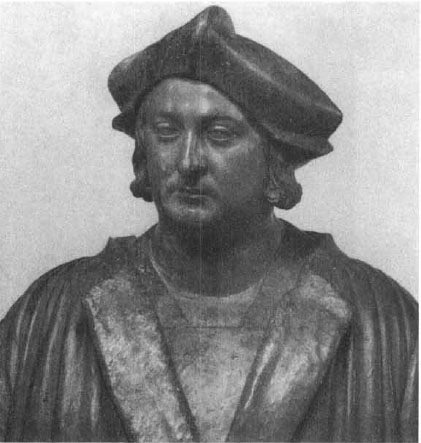
3a. Pietro Torrigiano’s bust of the young Henry VIII.
METROPOLITAN MUSEUM OF ART.
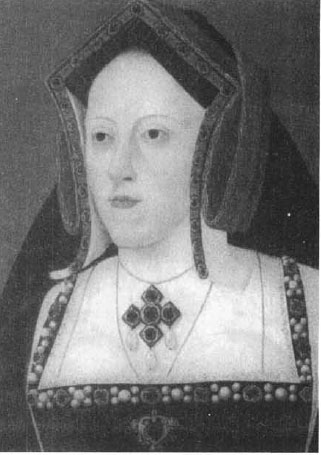
3b. Katherine of Aragon in middle age, ca. 1530. Artist unknown.
NATIONAL PORTRAIT GALLERY, LONDON.

4. Anne Boleyn. Artist unknown.
NATIONAL PORTRAIT GALLERY, LONDON.
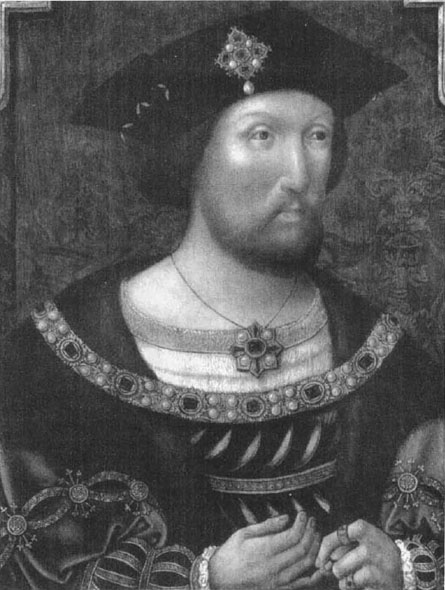
5. Henry VIII, ca. 1520. Artist unknown.
NATIONAL PORTRAIT GALLERY, LONDON.
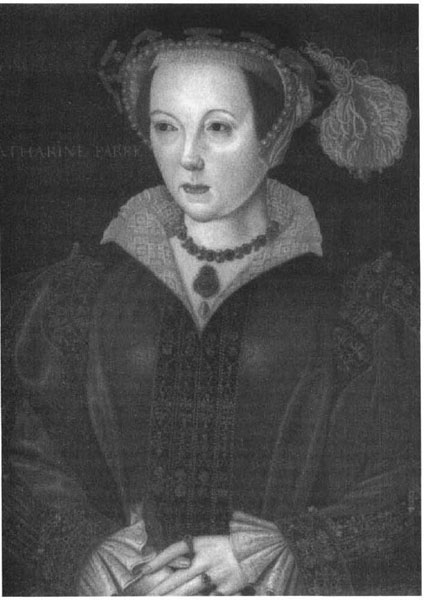
6. Catherine Parr, ca. 1550. Artist unknown.
NATIONAL PORTRAIT GALLERY, LONDON.

7. Elizabeth Tudor, ca. 1560. Artist unknown.
NATIONAL PORTRAIT GALLERY, LONDON.
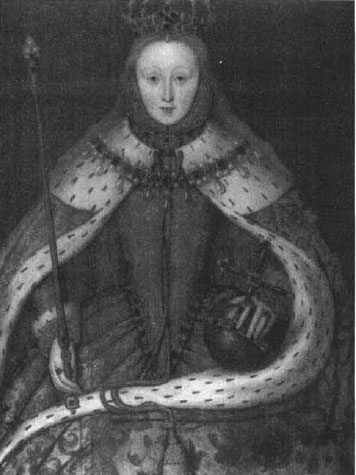
8a. Elizabeth I, coronation portrait. Artist unknown.
NATIONAL PORTRAIT GALLERY, LONDON.
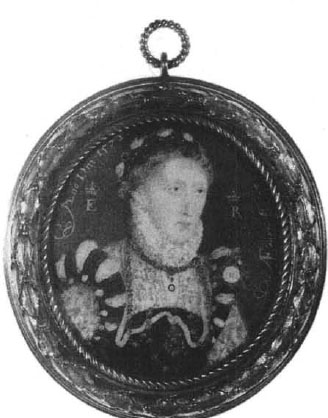
8b. Elizabeth I by Nicholas Hilliard, 1572.
NATIONAL PORTRAIT GALLERY, LONDON.
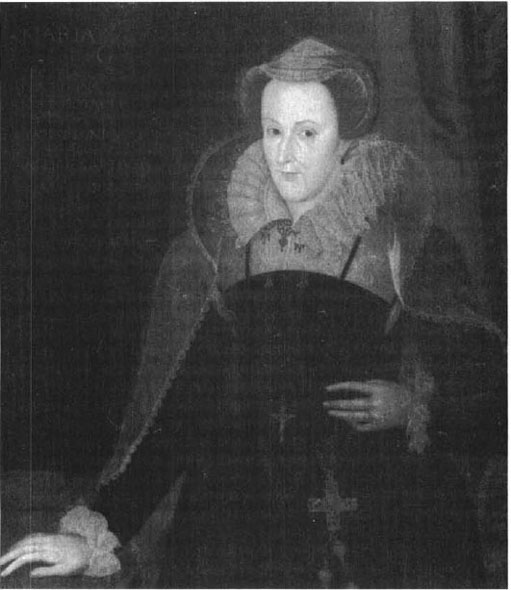
9. Mary, Queen of Scots, ca. 1578. Artist unknown.
NATIONAL PORTRAIT GALLERY, LONDON.
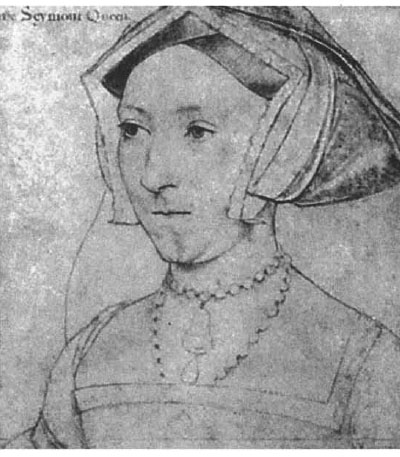
10a. Jane Seymour.
REPRODUCED BY GRACIOUS PERMISSION OF HER MAJEST
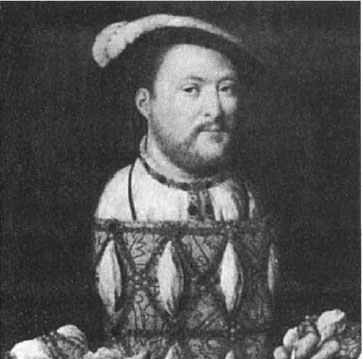
10b. Henry VIII, portrait attributed to Joos van Cleeve, conventionally dated 1536.
NATIONAL PORTRAIT GALLERY, LONDON.
It had been difficult enough for Henry to hold the country together in the face of these forces of disunity. He had done it by retaining an image of serene mastery, by finding temporary ways around each successive wave of the continuing crisis, and when all else failed, by prompt and terrifying displays of force. Through it all he had remained awesome. No rebellion succeeded in robbing him of his power. But it was evident from 1547 on that neither Edward nor his uncle had the prestige to remain aloof from the unrest that was closing in around them. Popular loyalty-was eroding under intolerable economic and social pressures. “What weapons can pacify or keep quiet the hungry multitude?” the author of an anonymous treatise asked the Protector. “What faith and allegiance will those men observe towards their prince and governor which have their children famished at home for want of meat?”3
In this atmosphere of fear and insecurity suspicion fell heavily on Mary. Writing to William Cecil about the risings Sir Thomas Smith, secretary of state, referred to “the Marian faction” in the population as if it posed an even greater threat than the rebels of the west and north. “As for the Marians, the matter torments me greatly, or rather, it nearly terrifies me to death,” he wrote. “Pray God of his mercy averts this evil from us.”4 He had good reason to be afraid, for though she remained aloof from the political struggles in the Council Mary was taking on an increasingly important public role.
To English Catholics Mary was becoming a popular symbol of resistance to religious innovation. As the religious policies of the Council were transforming the official faith she made her adherence to the old faith as obvious as possible. Where before she had heard the customary one daily mass she now heard two or even three or four, and had prayers in her chapel every night.5 When she went north to see the estates that had been assigned to her in Norfolk in the summer of 1548 the predominantly Catholic population gave her an enthusiastic welcome, and she made a display of her devout practices everywhere she went. “Whenever she had power to do it she had mass celebrated and the services of the church performed according to the ancient institution,” Van der Delft reported to the emperor.6
It was almost certainly this public defiance of the religion of the king and Council that led members of the government to meet with Mary on her return. What they said to one another we don’t know, but Mary’spopularity in the north was very much on the minds of the Council members when the men and women of Norfolk rose in revolt the following summer. The rebellion was in no sense a religious protest; Ket’s camp on Mousehold Heath followed the new English communion service and the rebels’ grievances were focused on their economic survival. Mary was back in the north when the revolt broke out, and she saw clearly that it had no confessional flavor. “All the rising about the parts where she was,” she said, “was touching no part of religion.”7 If proof were needed that Mary had nothing to do with promoting the rebellion, it could easily have been supplied. The rebels did protest on her behalf that she was “kept too poor for one of her rank,” but they treated her fences as roughly as those of any other landlord, pulling down the enclosure of her park and tramping through her lands.8
What no one in the government could have seen clearly as yet was that Mary was undergoing profound inner changes to accommodate the public role she felt herself called upon to play. She had always been predisposed to see life in monumental terms; now Catholicism and Protestantism became the huge polarities that overshadowed and drew to themselves every act and event in her experience. Her Catholic faith became much more to Mary than the dear belief of her childhood, the faith of the emperor and the regent, the church that had sustained her mother and for which so many of those she cherished had died. It was becoming the cause to which she devoted her being—as absolute and unyielding a commitment as that she had felt toward her mother’s cause long before.
Mary had always been a faithful Catholic. But what took shape within her now was so fundamental a merging of her self with her faith that it transcended religious devotion. It was a virtually complete identification of her personality and her destiny with the cause of Catholicism. Many years before Chapuys had urged Mary to save her life by giving in to her father and signing the Submission. He argued that in doing so she would be preserving herself to fulfill a higher destiny. Now that destiny was beginning to become clear. It would somehow be linked to her unswerving allegiance to the old faith, and to her emerging role as representative of all English Catholics.
The process was a slow one. It began when the remaining vestiges of Catholicism in England came under attack in 1547; it would not be complete until Mary herself took power. But signs of the transition were apparent from the first months of Edward’s reign, and by the spring of 1549 she saw clearly that she would soon come under pressure to abandon her faith and conform to the usages in Cranmer’s Book of Common Prayer—the form of service whose introduction in June of that year led to the western rebellion. When Van der Delft saw Mary on March 30 sheconfided to him how apprehensive she was about the consequences of her defiance. Her public manner was dignified, confident and determined; in private she felt vulnerable, anxious, increasingly concerned about the welfare of the country. To the ambassador she “complained bitterly of the changes brought about in the kingdom, and of her private distress, saying she would rather give up her life than her religion.”
Open conflict with the Council could not be avoided for long. When it came, she said, the emperor would be her only defender. This was true enough, though it is hard to believe Mary was entirely sincere when she told Van der Delft that “her life and her salvation” were in Charles’ keeping. She knew well enough that an attitude of helpless entreaty was what her imperial cousin expected of her, just as her father had, and exaggerated her desperation accordingly. But though Mary was no longer the terrified girl who had looked to the emperor almost as a savior in the 1530s, she still clung to the memory of what he and his sister had meant to her in those traumatic years. She showed the ambassador faded letters they had written to her at the time of her submission more than twelve years earlier. The letters were among her most cherished possessions, she said, and she took constant pleasure in them.9
Charles was unmoved by Mary’s sentimental gesture in keeping his letters, but he was concerned about her situation all the same. Her status as heir apparent gave her more political importance than ever, and the possibility that, through Mary, he might bring England within the Haps-burg fold was never far from the emperor’s mind. He had been hearing conflicting rumors about her safety. It was said in Flanders that Thomas Seymour’s rash invasion of the king’s bedchamber had been meant as only the first step in a much vaster plot to kill Edward and Mary both.10 In France it was being said that Mary herself uncovered the plot.11 And in England, Paget was alleging that “it was plain in every respect” that the admiral intended to assassinate Edward and his sisters, and that he had long since recommended putting Mary in the Tower.
That such a conspiracy could be divised and attempted from within the government Charles found distressing, especially as he had other grounds for complaint against the regime as well. Corruption in the policing of the seas, in the collection of customs duties and in the treatment of foreign merchants had been straining relations between England and the empire for some time. When Thomas Seymour’s goods were searched after his arrest it was found he had amassed a huge treasure in the purloined property of Flemish merchants—his share in the plunder of the pirates who were his confederates. Seymour’s successor as admiral, Lord Clinton, continued to ally himself with the privateers and to heap up riches from Flemish ships; when accused by the aggrieved foreigners hepretended ignorance. No justice was available to Flemish seamen in the Admiralty Court, and the fees charged by customs officials were twice what the law prescribed.
Orderly government in England appeared to be breaking down at an appalling rate, and imperial interests there were being damaged. Charles was therefore all the more predisposed to do what he could for Mary when she wrote to him in April, shortly after Van der Delft’s visit to her. She wrote of the plight of all English Catholics in “these miserable times” and stressed that “after God, your Majesty is our only refuge.” “We have never been in so great a necessity,” she went on, and alluded to the recent enactments making the English service the only tolerated form of worship. Mary urged Charles to do his utmost to ensure that she could “continue to live in the ancient faith, and in peace with her conscience.” “In life and death I will not forsake the Catholic religion of the church our mother,” she swore, even if compelled by “threats or violence.”12
Late in May, just before the violence of the summer months broke out, Charles began to put pressure on the Protector and Council to exempt Mary from obedience to the recent laws governing religion. Van der Delft asked Edward Seymour to give Mary “letters of assurance” guaranteeing that she would not be compelled to give up her faith and embrace the new orthodoxy. Seymour refused, saying he had no authority to act against parliamentary law, and that even if he did he could not bring himself to grant something so dangerous to the kingdom. Given the character of the nation, he said, “if the king and his sister, to whom the whole kingdom was attached as heiress to the crown in the event of the king’s death, were to differ in matters of religion, dissension would certainly spring up.” Mary could continue to worship as she liked, at least for the time being, but the Protector could offer no assurances for the future. The emperor was indignant, and told the ambassador to persist in his efforts, always “making use of all his cleverness so that the Protector may not interpret our words as threats of any kind, or imagine that we might resort to violence.” Van der Delft was to walk a tightrope between perseverance and intimidation; he was a far less skillful diplomat than Chapuys had been, and he found it hard going.
On the day that the new service was to become official, two commissioners from the Council, Secretary Petre and Chancellor Rich, came to Mary’s residence and informed her that she and all in her household were subject to the Act of Uniformity in religion. She stood firm and gave them a curt refusal, but they had not been sent to enforce the law, merely to state it unequivocally, and the confrontation was relatively mild. Not long afterward, however, Mary received a second message insisting on her compliance and peremptorily ordering two of her household officers, her controller Sir Robert Rochester and her chaplain Dr. Hopton, to appear before the Council.
Both the order and the summons angered Mary. She replied in a letter that her controller could not be spared and her chaplain was sick. As for her mass, she had broken no law in maintaining her manner of worship, she told the councilors, “unless it be a late law of your own making,” which could not be held as binding on her conscience. And she went on to lecture them about how they had broken the oath they took “upon a book” to keep King Henry’s religious settlement intact. The evil results of their changes were apparent “to every indifferent person,” she wrote—and even as she composed her letter revolts were spreading in Devon and Norfolk. They had brought displeasure to God and disquiet to the realm, and she would not lend support to their innovations lest Edward should later hold her accountable for them when he grew to manhood.
Mary’s protest was disregarded entirely. Rochester, Hopton and a third man in her household, Sir Francis Englefield, were summoned again and this time Mary let them go. The Protector’s tactic was two-edged. He hoped to frighten Mary, and to make her anxious about her servants; at the same time he seems to have believed that, if told by her own trusted men to alter her religion, she might obey. Rochester refused utterly to try to command his mistress, or even to convey a message to her from the Council. Hopton, slightly more flexible, agreed after being closely questioned by the Protector about his theological views to carry back “instructions” about the changes Mary was expected to make.
By this time the rebels were in control of large sections of the country, and no effective counterforce had yet been mustered. Exeter was in the hands of the insurrectionists, and Norwich soon would be. Van der Delft was worried because rebel ground lay between London and the country house where Mary was staying; he could not be sure of sending or receiving messages from her. Though he was preoccupied with meeting the growing threat to his government Somerset agreed to see the ambassador in mid-July. He was remarkably cool and reasonable, under the circumstances. Mary could continue as she was, he said, provided she no longer made a spectacle of her worship. “We have not forbidden the Lady Mary to hear mass privately in her own apartment,” he reiterated. “But whereas she used to have two masses said before, she has three said now since the prohibitions, and with greater show.” He added the frightening insinuation that through one of her chaplains Mary was implicated in the risings in the west. The Protector had heard that “the head of the Cornish rebels was her chaplain once,” he said, but made no further reference to the matter. (At the same time the Council wrote to Mary complaining that her receiver, one Pooley, was “a leader of the worst sort ofthe rebels in Suffolk.” According to Mary both accusations were groundless. )13
As the summer wore on the bloody course of the rebellions held the attention of the Protector and Council. Van der Delft and Somerset met once again in mid-August, but it was not until September, after the conclusive battles were won, that Paget and another councilor, Paulet, were deputed to state the Council’s position to the ambassador. They spoke of Mary with a surprising degree of deference and respect. They were sorry, they said, that such a “wise and prudent lady, the second person in the kingdom,” was so fixed in her views that she could not conform to the new service without doing violence to her conscience. They could not give Van der Delft the written letters of assurance the emperor asked for, but they were prepared to make a verbal promise “that she should freely and without hindrance or interference continue divine service as she had been accustomed to have it celebrated in her house, and that her priests and the members of her household should incur no risk.”14
Van der Delft was not satisfied with this solution, but Mary was. Written guarantees were in reality no more binding than verbal ones, and in any case Chapuys had trained her long ago to be wary of anything put in writing. Letters of assurance, she told the ambassador, might imply an acknowledgment of the laws against the mass which she had no wish to give. “These innovations were not laws,” she insisted, “for they were not duly given, but contrary to God, to her father’s will and the welfare of the realm.”15
Mary had come safely through the dangerous summer of 1549, but there were already signs of political upheavals to come. Somerset would soon come under attack, and Mary was under pressure to become part of the coup. She knew that her only safety lay in remaining aloof from political involvements until Edward came of age, yet her mounting concern for the state of the country tempted her to take action. There were some in the Council, notably Dudley, who would like nothing better than to accuse her of treason, and if the Protector were ousted Dudley would become the most powerful man in the Council.
In her dilemma Mary read and reread her old letters from the emperor and regent, prayed daily that God would have mercy on the councilors and “that matters might be restored as they were when the king her father left them,” and composed meditations to lift her thoughts above the vexed conditions of politics and the faith. She tried to remind herself that for the true Christian this world is only a temporary resting place on the soul’s journey to its home country. Beyond the pains of mundane life stretch the joys of eternity, when all that was once obscure shall be made clear in the light of God’s wisdom.
“This natural life of ours is but a pilgrimage from this wanderingworld, and exile from our own country,” she wrote in a “Meditation Touching Adversity” in 1549.
And lest the pleasantness and commodity of this life should withdraw us from the going to the right and speedy way to thee, thou dost stir and provoke us forward, and as yet ward prick us with thorns, to the intent we should covet a quiet rest, and end of our journey. Therefore sickness, weepings, sorrow, mourning, and in conclusion all adversities be unto us as spurs; with the which we being dull horses, or rather very asses, are forced not to remain long in this transitory way. Wherefore Lord, give us grace to forget this wayfaring journey, and to remember our proper and true country. And if thou do add a weight of adversity, add thereunto strength, that we shall not be overcome with that burden: but having our minds continually erected and lift up to thee, we may be able strongly to bear it. Lord! all things be thine; therefore do with all things without any exception as shall seem convenient to thine unsearchable wisdom. And give us grace never to will but as thou wilt. So be it.